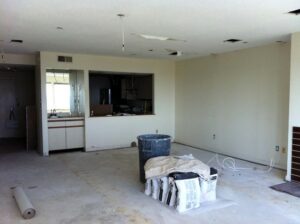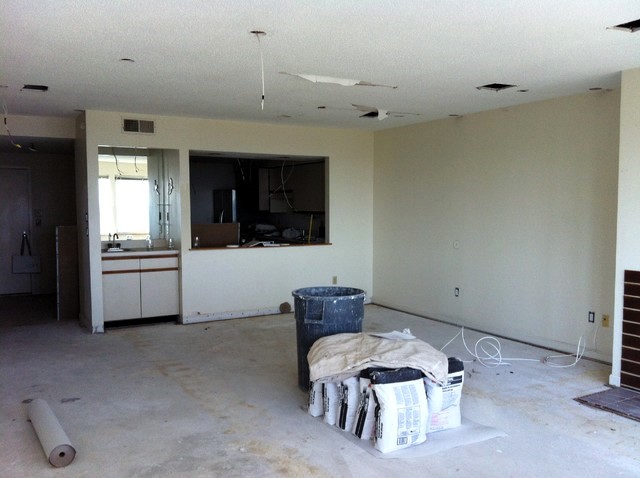Kitchen Remodel After Water Damage: Water damage is one of those unfortunate incidents that can turn your home upside-down, and your kitchen is no exception. The space where you whip up delightful meals can become a worrisome mess. Immediate action is crucial, but what comes after is equally important—remodelling your kitchen to restore its former glory and ensure safety.
Learn the essential steps to efficiently and effectively remodel your kitchen following water damage, ensuring a safe and beautiful cooking environment for years to come.

kitchen remodel after water damage
Types of Water Damage That Can Affect Kitchens
The kitchen can fall victim to various types of water damage, including:
- Flooding: Often due to natural disasters or severe plumbing issues.
- Leaky Pipes: A sneaky problem that can accumulate damage over time.
- Storm Damage: Wind and rain can lead to unexpected water issues.
Immediate Steps Post-Water Damage
Once you discover water damage, it’s vital to act quickly.
Dry out the area: Use fans, dehumidifiers, or professional services.
Mold Inspection: Look out for mold, which can be hazardous to health.
Contacting Insurance: Document the damage and reach out to your insurance company for coverage options.
Evaluating the Damage
Before you even think about paint swatches, evaluate the scale of the damage.
Structural Assessment: Check the integrity of walls and flooring.
Material Inspection: Evaluate which materials can be saved and what needs to go.
Deciding What Needs to Be Replaced: Make a list of all items that need replacement, such as cabinets or fixtures.
Working with Professionals
DIY might seem tempting, but this is one situation where you’ll want expert advice.
Consult Experts: Architects and interior designers can provide valuable insights.
Types of Professionals You’ll Need: Apart from designers, you might also require plumbers, electricians, and carpenters.
Planning Your Kitchen Remodel
Now, let’s get to the fun part—planning your new kitchen!
Budget Considerations: Create a financial plan before you start to avoid overspending.
Design Choices: Think about the layout, colour scheme, and overall aesthetics.
Upgrades to Consider: Now might be the perfect time to install that island or those high-end appliances you’ve always wanted.
Actual Remodeling Steps
This is where your plans come to life.
Replacing Damaged Wood and Drywall: Out with the old, damaged materials, and in with the new.
Repairing or Replacing Cabinetry: Make sure your cabinets are both beautiful and functional.
Installing New Fixtures: Light fixtures, faucets, and other smaller features can make a big difference.
Finishing Touches
Your kitchen remodel isn’t complete until you add those final personal touches.
Painting: A fresh coat of paint can brighten up the entire space.
Installing New Appliances: Bring in the new stove, refrigerator, or dishwasher you’ve been eyeing.
Final Inspections: Before you celebrate, have a professional ensure everything is up to code.
Navigating Insurance and Professional Assessments for Water Damage Repairs
When dealing with water-damaged kitchen cabinets, it’s crucial to consult with your insurance assessor, who will have the final say in the extent of repairs needed. Insurance assessors have extensive experience in evaluating such damages and will provide you with the most accurate estimate.
Avoid solely relying upon on-site supervisors for assessment, especially if they seem indifferent to the extent of the damage. In many cases, tradespeople like cabinetmakers may advise that more comprehensive repairs are necessary to fully rectify the water damage.
Key Takeaways:
- Immediately report the issue to your claims officer, detailing what the site supervisor and tradespeople are advising.
- The insurance company underwrites the repair work; if it’s not done properly, they are the ones who will bear the consequences.
- Always consult professionals who care about the quality of the work, such as your insurance assessor and experienced tradespeople, to ensure your cabinets are properly repaired.
Evaluating the Pros and Cons of Repairing vs. Replacing Your Cabinets
Facing water damage is undoubtedly an unplanned hassle. When considering repairs, it’s essential to evaluate the overall condition and layout of your existing cabinets. If your cabinets are not only damaged but also outdated or inconveniently designed, this could be the right time to make layout changes.
Aesthetic Considerations:
If you are pleased with the current design, color, and granite details, as they match other elements in your home like newel posts and balustrades, repairs may suffice.
Practical Considerations:
Assess if the current layout works for you. Are the undamaged cabinets in good enough condition to keep?
Personal Taste:
Your personal preferences in cabinet and countertop styles are essential. Some people prefer intricate granites with fine detailing, which could guide your choice between repairing the old or bringing in the new.
Personal Experiences: Practical Approaches to Cabinet Repair
There are multiple routes you can take to fix your water-damaged kitchen cabinets, each with its pros and cons.
Option 1: Clean, Prime, and Paint
A quick and less expensive method is to clean, prime, and paint existing cabinets and doors. This option works best for minor water damage but may wear out over time, especially with less durable materials.
Option 2: Complete Teardown and Rebuild
If you’re looking for a long-lasting solution, tearing down and rebuilding the cabinets could be the right choice. This option is more time-intensive but yields better results, especially if you work with a skilled woodworker. Pocket joining is a recommended technique for durability.
Considerations for a Rebuild:
If you opt for a complete rebuild, consider obtaining a cabinet build sheet and blueprints from the builder. These could assist you in the rebuilding process and even allow you the freedom to modify the layout to better suit your needs.
Conclusion:
Water damage is a headache nobody wants to deal with, but facing it head-on is crucial. With careful planning and the right professionals, you can turn a disaster into an opportunity for a beautiful kitchen remodel.
FAQ Section Of Kitchen Remodel After Water Damage
Can water-damaged kitchen cabinets be repaired?
Yes, it’s possible to repair water-damaged cabinets, especially if you catch the damage early. Removing all moisture and perhaps refinishing the wood can often restore them.
What should I replace after water damage in the kitchen?
Structural elements like wood and drywall should be your first priority, followed by cabinetry and appliances that were severely affected.
What steps are crucial immediately following water damage?
Act fast by drying out the area, inspecting for mold, and contacting your insurance provider. The quicker you act, the less severe the long-term damage will be.
How long should you wait after water damage before starting a remodel?
The wait time can vary based on the extent of the damage and the speed of your initial response. However, it’s generally advisable to start the remodel after the area is completely dry and has been inspected by professionals.
Is it worth upgrading my kitchen features during a water damage remodel?
Absolutely! If you’re already investing time and money into a remodel, it might be the perfect opportunity to upgrade features like countertops and appliances for a modern, efficient kitchen.

